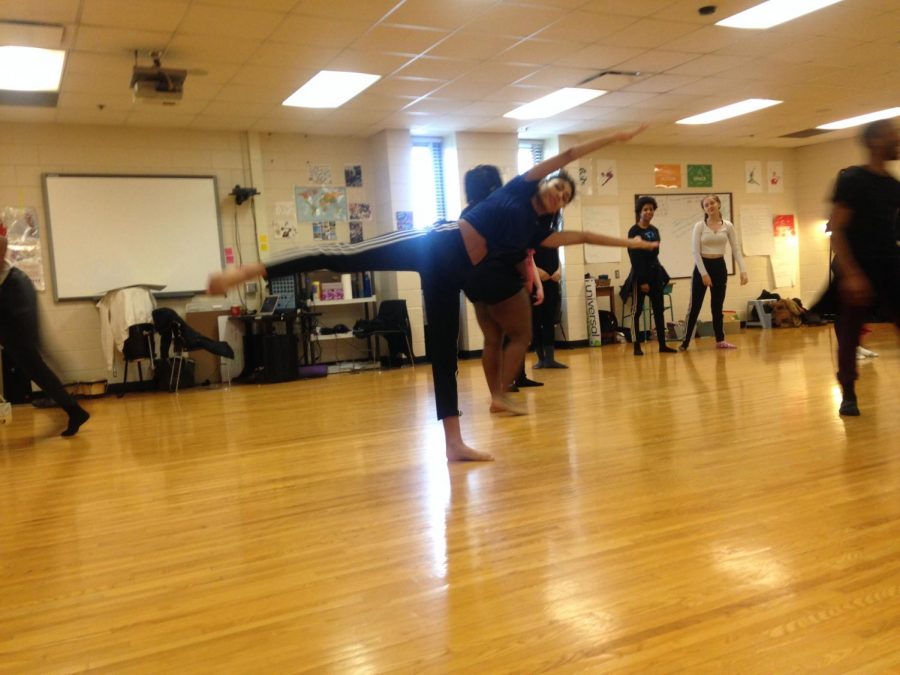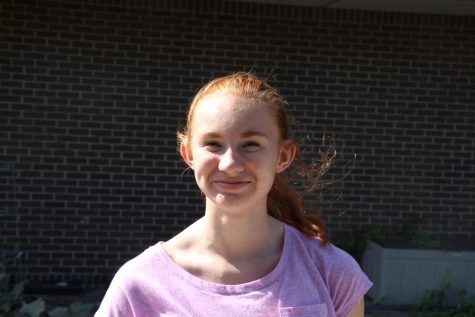Students express themselves through choreography
South High students warming up in the classroom. Dance can be used to express and articulate issues as art and exercise. This art form can be seen all throughout South, including school dances and the May Day parade. Haakon Anderson, a sophomore and member of Dance Company I, explained, “I like being able to express myself and the community aspect especially in Company. In my group… we are all in this together and we teach each other and grow off of that.” Photo courtesy of Nancy Nair.
June 4, 2018
Movement to make a statement– that’s what Olivia Sather, a freshman in the Dance Company I, thinks of dance. “Dance and art in general is such an outlet for emotions and has a way to let the world know about them in a new way. It’s a way to be an activist very personally,” said Sather. “You become so much stronger physically and more aware emotionally.”
Dance has been used throughout history to make a statement, whether that is to protest something you believe in, communicate an emotion, celebrate a victory, or grieve a loss. This movement, like all forms of art, helps society as a whole become more social and form bridges that might not otherwise exist without art. A current example of dancing as a form of protest was on the night of Donald Trump’s inauguration in 2017: LGBTQ+ activists walked and danced over a mile to Mike Pence’s house in Maryland to protest his stance on LGBTQ+ rights. This form of protest was peaceful yet effective in showing that a group stands together to fight for a cause they believe in.
Overall, most people can agree that dance is a way to express emotion and creativity. Bela Toscani, a senior and member of Dance Company II, explained creativity as “forcing you to use your imagination. It’s the power to bring something to existence that wouldn’t be there if you hadn’t imagined and pursued that idea.”
Nancy Nair, the South High Dance teacher, explained creativity as “having an intimate relationship with one’s imagination and trusting the output of ideas from that relationship that results in action.”
There is also a sense of community felt in the dance program, especially at South. Toscani explained, “I love all the dancers in the company and I’ve had a really strong relationship with both the [dance] teachers[at South].” Sather expressed the same: “My favorite part of dance is everything. The community you build, the art you share with the world, and the strength you build.”
Haakon Anderson, a sophomore and member of Dance Company I, explained, “I like being able to express myself and the community aspect especially in Company. In my group we are like we are all in this together and we teach each other and grow off of that. We all have dance together so it’s easy to connect.”
One way to express creativity in dance is through choreography. The approach to creating a dance is different for every type of dance, group, and dancer. “Everyone has a different process of choreographing that works for what they want their final product to look like, or what kind of relationships or connections they want to be made through the process,” Sather said. “For me, I started with a theme and a visualization of what I wanted the picture to look like onstage. Then I do the progression of spacing and what kind of feelings I want my dancers to convey through the different parts of the dance…. I try to put feelings and messages behind my moves, but in the end, it’s about the dancers knowing what they’re dancing for,” she continued.
Toscani expressed a similar idea of the process of choreography as Sather. “The process of choreographing a dance is really dependent on the choreographer… Because dance is an art form, there’s always room to improve on a piece. That’s why it can take years to create a dance and sometimes only a few hours or weeks,” she said. “For me, choreography really allows me to navigate my emotions or feelings about something going on in my life or something I want to shed a light on.”
Nair has substantial background in choreography after being a dance teacher for over twenty years. “The length of time depends usually on how much time we have. It can be anywhere from five days to five weeks. I try to take into consideration the purpose and message of the dance [and] then we can lay a foundation of context for the dance.”
One personal experience Nair had choreographing was with Dance Company II for swing night. She explained, “We set the piece at a party in Gatsby’s house (from The Great Gatsby). Having a sense of place allowed the students to step into character and embrace the movement at a rate that helped them connect with the movement quickly, as well as retain it in their bodies. For one of the dance, we created a cypher [a sort of code in the dance] where students created small moments of “trick” choreography with their partner. This helped them to have fun with their own creative and collaborative process, as well as learning new moves with the bigger ensemble. I try to draw as much as I can from my dancers so they have a sense of ownership in their movement, to feel that the moves are coming from within them, not outside of them.”
Anderson explained that his process choreographing usually involves listening to the song on repeat many times. “My inspiration usually comes from hearing a song or music so if hear something I really like I’ll be like ‘yes I like this song, this is really great’ and I will incorporate moves into the song. Then I’ll sit down for like two hours and just count out the song in eight counts… and listen to the song and take moves I know and like and put it into the song.”
Although the process of creating a dance is demanding, with dancers putting their blood, sweat, tears, and energy into their creation, most can agree that the outcome is pretty amazing. Sather explained, “This year was my first time choreographing and then having to teach peers and try and get them to see my vision… Sometimes I expect too much of people, or really expect them to read my mind. Obviously you can’t expect people to do that, so you have to find a way to understand. Through that process, I learned more about myself as a dancer and now as a teacher.”
Anderson explained that seeing his long hours of work and commitment on stage is an amazing experience. “Seeing your work executed on stage is very satisfying. Hearing positive audience reaction while on stage is immensely satisfying. It gives you a sense of pride and accomplishment,” he explained.
Nair believes that the experience of teaching dance to students and watching them perform is magical, as well as connecting. “It’s always nothing short of a magical experience for me to work with dancers collaboratively in an effort to use our bodies to make art. I feel so connected to my dancers when I am working on a piece of choreography, almost as if I am dancing through them,” she said.






